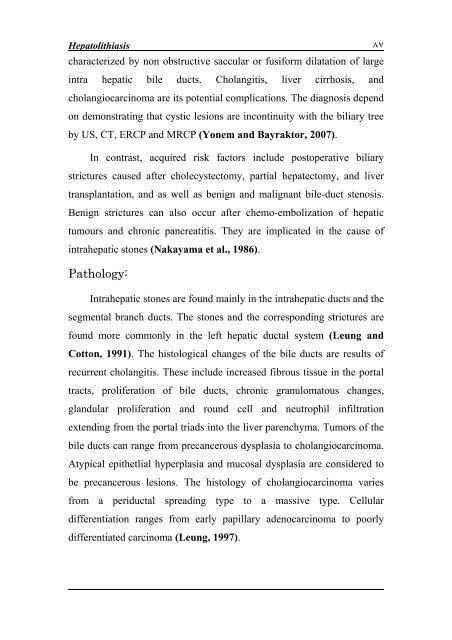Parasites and Biliary stones
Parasites and Biliary stones
Parasites and Biliary stones
You also want an ePaper? Increase the reach of your titles
YUMPU automatically turns print PDFs into web optimized ePapers that Google loves.
Hepatolithiasis ٨٧<br />
characterized by non obstructive saccular or fusiform dilatation of large<br />
intra hepatic bile ducts. Cholangitis, liver cirrhosis, <strong>and</strong><br />
cholangiocarcinoma are its potential complications. The diagnosis depend<br />
on demonstrating that cystic lesions are incontinuity with the biliary tree<br />
by US, CT, ERCP <strong>and</strong> MRCP (Yonem <strong>and</strong> Bayraktor, 2007).<br />
In contrast, acquired risk factors include postoperative biliary<br />
strictures caused after cholecystectomy, partial hepatectomy, <strong>and</strong> liver<br />
transplantation, <strong>and</strong> as well as benign <strong>and</strong> malignant bile-duct stenosis.<br />
Benign strictures can also occur after chemo-embolization of hepatic<br />
tumours <strong>and</strong> chronic pancreatitis. They are implicated in the cause of<br />
intrahepatic <strong>stones</strong> (Nakayama et al., 1986).<br />
Pathology:<br />
Intrahepatic <strong>stones</strong> are found mainly in the intrahepatic ducts <strong>and</strong> the<br />
segmental branch ducts. The <strong>stones</strong> <strong>and</strong> the corresponding strictures are<br />
found more commonly in the left hepatic ductal system (Leung <strong>and</strong><br />
Cotton, 1991). The histological changes of the bile ducts are results of<br />
recurrent cholangitis. These include increased fibrous tissue in the portal<br />
tracts, proliferation of bile ducts, chronic granulomatous changes,<br />
gl<strong>and</strong>ular proliferation <strong>and</strong> round cell <strong>and</strong> neutrophil infiltration<br />
extending from the portal triads into the liver parenchyma. Tumors of the<br />
bile ducts can range from precancerous dysplasia to cholangiocarcinoma.<br />
Atypical epithetlial hyperplasia <strong>and</strong> mucosal dysplasia are considered to<br />
be precancerous lesions. The histology of cholangiocarcinoma varies<br />
from a periductal spreading type to a massive type. Cellular<br />
differentiation ranges from early papillary adenocarcinoma to poorly<br />
differentiated carcinoma (Leung, 1997).
















